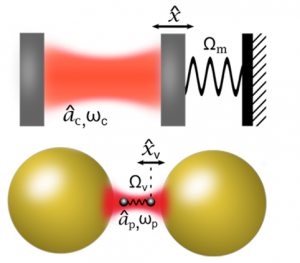Ever since its discovery in 1974 [1], SERS has revolutionized the field of Raman spectroscopy by demonstrating sensitivities down to single molecule [2,3]. However, precise mechanisms which govern SERS are still poorly understood, in particular under strong laser driving. To address this issue, we fabricate well-defined nanocavities with sub-2-nm gaps and sharp plasmonic resonances, which exhibit reproducible SERS signals. In these structures the local density of state depends strongly on wavelength, modifying the response of the system as a function of the laser detuning.
To obtain a more accurate description of SERS and gain new insights into optically-induced vibrational dynamics, a new model based on the principles of cavity optomechanics was recently developed, which considers the Raman active molecules as mechanical oscillators parametrically coupled to a nanocavity via their Raman polarizabilities [4]. This description predicts a modification of the vibrational occupancy induced by the laser, with two distinct contributions. At low power, “quantum backaction” is dominant. It is caused by the intrinsic asymmetry of the anti-Stokes vs. Stokes scattering rate, which privileges the Stokes process and causes an increase in the vibrational occupancy proportional to laser power. In the regime of higher power and extreme Raman enhancement, the theory predicts the onset of dynamical backaction, a nonlinear phenomenon which corresponds to sideband amplification under blue detuned excitation.
References:
[1] Fleischmann, Chem. Phys. Letter 26 (1974)
[2] Nie, Science 275, (1997)
[3] Kneipp, Phys. Rev. Lett. 78, (1997)
[4] Roelli, Nat. Nanotech. 11, (2016); Schmidt, Faraday Discuss. 205, (2017)
Funding: ERC Consolidator Grant QTONE

Fig. 1: Concept of molecular cavity optomechanics
Fig. 2: The nanoparticle-on-mirror geometry offers huge field enhancement and is easy to fabricate
